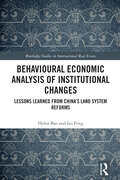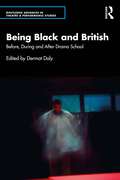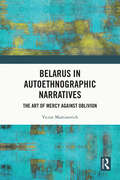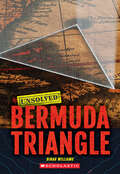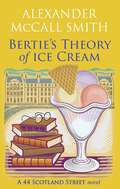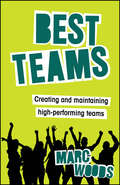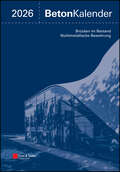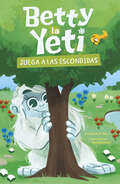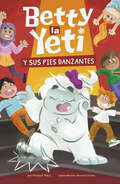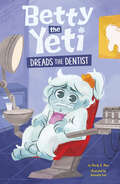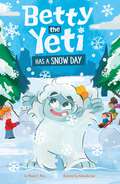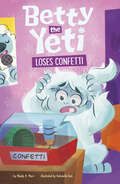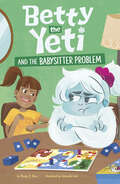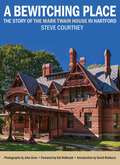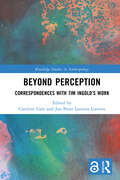- Table View
- List View
Becoming a Reflective Practitioner
by Christopher JohnsFully updated edition of a seminal text in the field providing an in-depth guide to reflection and its real-life application The Seventh Edition of Becoming a Reflective Practitioner offers an in-depth exploration of reflective practice, bringing the process of guided reflection to life. The book emphasises the importance of person-centred practice aligned with the latest developments in holistic healthcare and features a variety of case studies and real-life scenarios that illustrate the application of reflective practice in clinical settings. The book is structured into five parts, moving from the concept of reflection and its application in clinical practice to its integration into formal education, narrative representation, and performance. The new edition includes significant updates and expansions on topics such as the development of guidance in reflective practice, as well as the inclusion of new chapters that highlight the reflexive process of guiding practitioners over the course of a year. Becoming a Reflective Practitioner, Seventh Edition includes information on: The Six Dialogical Movements and their assimilation within the Model for Structured Reflection (MSR)Experience, vision, knowing in practice, the prerequisites for reflection, the reality wall, and the movement of reflective learning through understanding, empowerment, and transformationThe nature of guidance and the dynamic process of guidanceNarratives of guiding practitioners within the clinical setting constructed through guided reflection dialogueLeadership development through establishing a clinical learning culture based on the learning organisation and clinical supervision Becoming a Reflective Practitioner continues to be an essential resource for students, educators, and practitioners aiming to enhance their reflective practice and achieve their visions of person-centred care.
Becoming a YouTube Musician: How People Learn, Create, and Connect Online (Routledge New Directions in Music Education Series)
by Christopher CayariAs the most-visited social media site on the internet, the video-sharing platform YouTube has become a highly influential space for musicmaking and learning. Becoming a YouTube Musician: How People Learn, Create, and Connect Online explores how YouTube creators and viewers are using digital video to create and consume music, develop online communities, and engage in formal, informal, and experimental music learning.Drawing on 26 case studies, the author challenges music educators to incorporate the learning, creative, and social practices of online musicians into their classrooms by helping students learn to participate in an online music system like YouTube. While this book serves as an in-depth analysis of a specific platform, the concepts within are more universal. Becoming a YouTube Musician encourages readers to consider how technology, media, and the internet can be used to innovate teaching by incorporating popular practices that exist on social media. The author shows educators how to apply lessons from the practices of YouTube musicians in their classrooms, facilitating student creativity and engagement in new ways.
Becoming in Global Trans Studies: Critical Approaches to Educational Theory, Methodology, Ethics, and Politics (Routledge Critical Studies in Gender and Sexuality in Education)
by Shanshan Zhang Z Nicolazzo Pin-Ru Su Ting-Yen HoThis ground-breaking book explores the increased visibility of trans people in various academic fields of study including education. It asks who this visibility benefits, and how. With much of the Trans Studies literature in education yet to seriously consider trans as a global phenomenon, or anything beyond an embodied reality, the authors present new possibilities for trans as a global concept, interrogating the Western, trans-normative discourses in education scholarship. In doing so, they introduce a new, transnational lens for the discussion of trans and gender issues in higher education, explore the elucidation of a "new" Trans Studies in education from various perspectives, and demonstrate how trans extends beyond an embodied or material construct.A bold reconceptualization of trans in educational contexts, this book argues that the "new" trans studies can—and must—alter how we think, know, view, feel, and describe the phenomenon of gender. It will appeal to scholars, faculty, graduate students, early career scholars and critical educators with interests in gender and sexuality in education, gender-related scholarship, Trans Studies and international education.
Behavioral Economic Analysis of Institutional Changes: Lessons Learned from China's Land System Reforms (Routledge Studies in International Real Estate)
by Helen Bao Lei FengThis book examines the evolution of China’s rural land system through an integrated lens of institutional and behavioural economics. It traces seventy years of reform, from collective farming to market-oriented land transfers, to explain how central policy, local implementation and farmers’ responses interact to shape institutional change. Moving beyond standard accounts focused on property rights and transaction costs, the book introduces a dynamic framework based on Prospect Theory, incorporating cognitive biases, social norms and bounded rationality. Drawing on two large-scale rural household surveys, the book combines empirical analysis with historical case studies to explore how reforms were received, adapted and resisted.This book will benefit researchers, policymakers and graduate students interested in institutional change, land policy or Chinese rural development. It offers new tools to understand policy implementation in environments marked by uncertainty, decentralisation and informal constraints. By highlighting how behavioural factors mediate formal rules, the book provides insights that extend beyond China, informing the design of effective land and property rights reforms globally.
Behavioral Insights in Cybersecurity: A Guide to Digital Human Factors (Security, Audit and Leadership Series)
by Dustin S. SachsBehavioral Insights in Cybersecurity: A Guide to Digital Human Factors by Dr. Dustin S. Sachs is a timely and essential resource for cybersecurity professionals, leaders, and organizational strategists seeking to understand the powerful role of human behavior in shaping digital security outcomes. Bridging the gap between behavioral science and cybersecurity, this book challenges the traditional reliance on purely technical defenses and explores why human error accounts for up to 95% of cybersecurity breaches. Drawing from psychology, cognitive science, and organizational behavior, Dr. Sachs provides a compelling framework for rethinking how individuals, teams, and systems interact in high‑stakes digital environments.Through real‑world examples and practical strategies, the book examines how cognitive biases, decision fatigue, stress, and cultural dynamics influence security performance. Leaders will learn to recognize and mitigate biases like availability and confirmation bias, implement structured decision‑making processes, and foster cultures that prioritize security without sacrificing usability or autonomy.This book introduces the “Technology Strategy Needs Pyramid,” a human‑centric model that moves beyond compliance to build mature, resilient, and ethically grounded cybersecurity ecosystems. From designing intuitive interfaces and leveraging behavioral analytics to implementing AI‑driven adaptive defenses and ethical nudging, Dr. Sachs equips readers with actionable tools to align human tendencies with security goals.Whether addressing insider threats, social engineering, or the limitations of legacy awareness training, Behavioral Insights in Cybersecurity advocates for a holistic approach that integrates technology, behavior, and culture. It is a must‑read for cybersecurity leaders seeking to create sustainable, secure environments where people are not the weakest link—but the strongest asset.This book is not just a guide—it’s a call to reimagine cybersecurity leadership through the lens of human behavior, ethics, and strategic decision‑making.
Behaviourist Art and Cybernetics: Mapping a Field (Routledge Advances in Art and Visual Studies)
by Kate SloanDrawing together key areas of cybernetic art practice in the UK and USA, this book assesses British and American cybernetic art as relating to the intersecting field of Behaviourism.This study takes as a starting point Roy Ascott’s essay ‘Behaviourist Art and the Cybernetic Vision’ (1966) and uses it to define a field of Behaviourist art from the period 1945–1975. Kate Sloan establishes the role of the cybernetic concept of feedback as a defining factor in understanding works of art as behavioural, expanded well beyond the perimeters of what we consider cybernetic art. The book also demonstrates how light, as a behavioural trigger, informed several discrete areas of art making, from cybernetic art to countercultural light shows and behaviourist architectures.The book will be of interest to scholars working in art history, technology studies, music history, architectural history, and design history.
Being Black and British: Before, During and After Drama School (Routledge Advances in Theatre & Performance Studies)
by Dermot DalyBeing Black and British: Before, During and After Drama School is about being Black, being British and being an actor before, during and after training.Written by Black writers working in and around the British performative industries, this book offers practical and theoretical tools to take into the classroom, studio, rehearsal room, mind, body and heart, focalised unapologetically through being Black in Britain. Structured across three acts, it covers themes present on the road to drama school such as youth theatre, the texts studied and early experiences in theatre spaces; drama school training with practical suggestions to encourage and embolden Black actors; and the world of the profession, ensuring that mental health, making work and a sense of what can be offered by Black actors is made clear.This book is a call to action and a challenge to all those who teach, lecture, direct, parent, produce, cast and/or train Black performers in Britain – and those performers themselves, to listen more, ask more, feel more and be more.
Belarus in Autoethnographic Narratives: The Art of Mercy Against Oblivion
by Victor MartinovichThis book offers an autoethnographic exploration of the interplay of art, memory, and resilience in Eastern Europe, weaving together the personal and collective histories of Belarusians – those who survived two World Wars and their contemporaries, who are now looking for a way out of a political crisis in the region.Set against the history of Belarus, it recounts the story of the author’s greatgrandfather Amyalyan, a Belarusian peasant executed by the Nazis after saving a Jewish man during World War II, along with reflections on artists like Chaïm Soutine and Marc Chagall, whose journeys reflect the region’s cultural endurance. Combining autoethnography and art history, this book presents art as a medium of empathy, challenging readers to engage with paintings emotionally rather than through a purely analytical lens. Each chapter functions as both a historical reflection and an invitation to see art as a means of reclaiming personal narratives, making historical traumas accessible and relatable. Themes of compassion, forgiveness, and the humanizing power of art emerge as essential elements, guiding readers through the complex intersections of personal and collective memory.This book is a valuable addition for researchers and students interested in ethnography and autoethnography, Eastern European studies, art history, cultural studies, and memory studies.
Bermuda Triangle (Unsolved)
by Dinah WilliamsDiscover the unsolved mystery of the Bermuda Triangle in this beautifully illustrated book for kids, accessible for all readers!The Bermuda Triangle is a mysterious place in the Atlantic Ocean. Dozens of ships and planes have disappeared there. Is it because of the bad weather, or is there something supernatural?Discover this unsolved mystery with real clues, facts, and pictures in the pages of this book. The story will unfold with easy-to-read text and exciting visuals. You can decide for yourself what you think is happening in the Bermuda Triangle!ABOUT THIS SERIES:Take a deep dive into some of the most unbelievable but real unsolved mysteries from history. Is the Bermuda Triangle cursed? Do sea monsters exist? Can people just disappear? Each book in this series focuses on one unsolved mystery and describes its main events chronologically. Readers follow along as the exciting narrative uncovers real historical clues. Multiple theories are presented, providing an opportunity for readers to draw their own conclusions. The most up-to-date facts and relevant modern-day discoveries are included to allow for real-world connections. Perhaps you will be the one to solve an unsolved mystery!
Bertie's Theory of Ice Cream (44 Scotland Street #18)
by Alexander McCall SmithBook 18 in the hugely popular 44 Scotland Street series by worldwide bestselling author Alexander McCall Smith"It's like ice cream, Mr Flynn," Bertie continued. "When you have ice cream, you need to eat it straight away, otherwise it melts. If there are people who haven't got any, you should share it, if you can."When despair for the world grows, Bertie's theory of ice cream reminds us that it's the simple pleasures in life that we should hold onto. And everyone's favourite seven-year-old has a lot to put up with: at home, Irene is planning lessons on Irish Culture for Bertie; at school, he is forced to join Olive and Pansy's book group, and during a day out with his best friend Ranald Braveheart Macpherson, the boys find themselves unexpectedly invited to a wedding.Meanwhile, Bruce's latest property venture goes horribly wrong after trying to move a flat's front door to give it a more prestigious address. At Nine Mile Burn, Matthew and the triplets try to adopt an unwillingly-vegan dog. And Sister Maria-Fiori dei Fiore Montagna discovers the missing part of the Stone of Scone in Drummond Place Gardens.Filled with Alexander McCall Smith's trademark warmth and humour, this latest book in the series is a must-read.
Best Practice in Labour and Delivery
by Sabaratnam ArulkumaranThe focus of the third edition of Best Practice in Labour and Delivery is on improvement of technical and non-technical skills, multidisciplinary team working, high quality training and audit with the goal of improving safety and quality of intrapartum care. The editor and authors from a range of international backgrounds have decades of hands-on experience in managing high risk labour wards and promoting both multidisciplinary working and high-quality training. The latest evidence from the Cochrane library and the WHO, NICE and RCOG guidelines have been incorporated into chapters spanning the stages of labour and delivery and the complications that may arise. Chapters also provide practical advice on risk management, triage and prioritisation, and non-technical skills such as leadership and decision making. The well-illustrated book is an essential read for practicing obstetricians, trainees, midwives, neonatologists, anaesthetists and obstetric physicians.
Best Teams: Creating and Maintaining High-Performing Teams
by Marc WoodsA complete model to create and manage high-performance teams within any organisation or industry Best Teams: Creating and maintaining high-performing teams presents a unique model to create high-performing teams. This model is centred around three deeply intertwined elements. Empowered people, where each team member has a strong work ethic, is given autonomy, has integrity and a growth mindset. Defined processes, which ensure that high-quality communication, goal setting, accountability, and recognition is consistently delivered throughout the organisation. Supportive cultures, which prioritise cultivating a culture of resilience, psychological safety, inclusion, and a One Team Ethos. Working on these attributes individually and collectively will help create high-performing teams within your organisation. After exploring the basics of the model and the underlying theory behind it, this book takes a deep dive into: Real-world examples of individuals and companies that have nailed each part of the model In-depth interviews with leaders from world-class organisations—including elite sports teams like Aston Martin Aramco Formula One™, global businesses, and pioneering startups Exercises and tools you can work on as an individual and collectively to develop tangible skills The real effects of high-performing teams: 21% more profitability, 17% higher productivity and a 41% decrease in absenteeism Best Teams: Creating and maintaining high-performing teams is a thought-provoking and highly practical guide to success for team leaders and members in organisations of all sizes seeking to bring their best to work and help their teams achieve optimal productivity, profitability, and wellbeing. If you're building a team that wants to do more than just perform—if you want to thrive—this book is for you.
Beton-Kalender 2026: Schwerpunkte: Bauen im Bestand; nichtmetallische Bewehrungen (Beton-Kalender)
by Konrad Bergmeister WienBetty la Yeti juega a las escondidas (Betty la Yeti)
by Mandy R. MarxEn un juego de las escondidas, ¿dónde puede esconderse una yeti? In a game of Hide-and-Seek, where can a yeti hide?
Betty la Yeti odia el espagueti (Betty la Yeti)
by Mandy R. MarxBetty la Yeti prueba algo nuevo y hace un nuevo amigo. Betty the Yeti tries something new and makes a new friend.
Betty la Yeti y el primer día de clases (Betty la Yeti)
by Mandy R. Marx¡Sigue a Betty la Yeti en su primer día de clases con seres humanos! Follow Betty the Yeti on her first day of human school!
Betty la Yeti y sus pies danzantes (Betty la Yeti)
by Mandy R. Marx¿Pueden los pies danzantes de Betty la Yeti ayudar a los estudiantes a seguir el ritmo? Can Betty the Yeti's dancing feet help the students keep the beat?
Betty the Yeti Dreads the Dentist
by Mandy R. MarxIt's time for Betty the Yeti to visit the dentist! She's worried. Her brother Eddy and her friend Cecilia told her about their dentist appointments. Now Betty dreads going to the dentist. What will Betty do to deal with her fears?
Betty the Yeti Has a Snow Day
by Mandy R. MarxA big snowfall means Betty and her friends have a snow day! They go to the park to make snowmen and go sledding. But what happens when Betty is too big to fit in the sled with her friends?
Betty the Yeti Loses Confetti
by Mandy R. MarxBetty’s class has a new pet named Confetti! Betty doesn’t think she’ll like this new creature. Cecilia takes it home for the weekend and helps Betty get over her fears. But what happens when Betty can’t find Confetti?
Betty the Yeti and the Babysitter Problem
by Mandy R. MarxBetty the Yeti has a problem. The new babysitter doesn't know how to make Betty's favorite sandwich or what to play with her. Can Betty speak up for herself in order to have a fun time?
Bewitching Place: The Story of the Mark Twain House in Hartford
by Steve CourtneyA Bewitching Place: The Story of the Mark Twain House in Hartford is the official guide to The Mark Twain House & Museum, an institution dedicated to preserving the author's home, literary legacy, and life story. Author Steve Courtney, the organization's Publicist and Publications Editor, conducts a journey back to the Gilded Age, when the celebrated author and humorist was known as Mr. Samuel Clemens of Hartford, Connecticut. Readers can venture inside "a bewitching place" for an illustrated tour that offers intimate glimpses of the writer, his wife, and their daughters within their Victorian mansion. Abundantly illustrated with architectural drawings and period photos, this volume also features dozens of recent color images. Built in the American Gothic tradition, the richly appointed house features the decorative work of Louis Comfort Tiffany and contains many souvenirs of family trips to Europe. During the seventeen years that he lived in the Hartford home, Sam Clemens completed The Adventures of Tom Sawyer (1876) and Adventures of Huckleberry Finn (1884), along with The Prince and the Pauper (1881)and A Connecticut Yankee in King Arthur's Court (1889), in addition to countless lectures, magazine pieces, and stories improvised for the children's delight. The narrative traces the house's history beyond the Clemens family's residence, from its 1903 sale to its current status as a lovingly preserved and restored National Historic Landmark. This updated edition includes two new chapters and additional full color photos throughout.
Beyond Code: Redefining Programming Education Beyond STEM
by James Hutson Daniel PlateAI-powered coding tools are revolutionizing software development, transforming programming from a specialized skill into an accessible educational practice across disciplines. This book investigates how tools such as Cursor AI, GitHub Copilot, and Replit's Ghostwriter are dismantling traditional barriers to entry for learners—particularly those from non-STEM backgrounds—by enabling natural language code generation, intelligent debugging, and interactive, project-based learning. Bridging the gap between theoretical instruction and practical application, the book serves as both a guide and a critical framework for integrating generative AI into curricula. It highlights how these tools expand the boundaries of programming education by supporting interdisciplinary applications, from literary analysis to creative writing, thereby making coding relevant and actionable for students in the humanities and beyond. The book equips educators with the tools and strategies necessary to incorporate AI-assisted programming into diverse academic contexts by offering lesson plans and adaptable project models. This resource is essential for instructors seeking to demystify coding, promote inclusivity in technical learning, and reimagine the role of software literacy in the twenty-first-century classroom.
Beyond Loneliness: Experiences of Individual and Community Social Connection
by Jane Farmer Milovan Savic Tracy De CottaThis Open Access book reimagines social connection beyond the crisis narrative of loneliness, presenting an innovative interdisciplinary model that bridges individual experiences with community infrastructure. Drawing on research with urban fringe residents, the authors reveal how meaningful connections form through complex interactions across physical and digital spaces, shaped by environmental contexts and personal capabilities. Beyond Loneliness offers a strengths-based framework through rich thematic analysis and six powerful, detailed personal narratives that illuminate connection journeys. It demonstrates how people actively navigate their social worlds and shows how contextual factors, including social, built, technological, and institutional, influence connection opportunities. For practitioners, policymakers, and researchers, this accessible book provides practical insights for fostering environments where diverse pathways to social connection can flourish. By moving beyond deficit-focused interventions toward comprehensive strategies that recognise social connection as a dynamic, relational process, Beyond Loneliness offers a transformative approach to building more connected, resilient communities.
Beyond Perception: Correspondences with Tim Ingold's Work (Routledge Studies in Anthropology)
by Gatt, Edited by CarolineThis book showcases the way a range of scholars have engaged with Tim Ingold’s opus since the publication of his ground-breaking The Perception of the Environment in 2000. Ingold’s work has become key for a variety of disciplines ranging from anthropology, archaeology, and human geography to art, architecture, design and studies of material and visual culture. As set out in The Perception of the Environment and subsequent publications, Ingold proposed an understanding of the world that placed sentient, remembering and imagining organisms, or inhabitants, some of them human, at the heart of an extensive field of socio-ecological relations. In this work, Ingold develops broad-ranging analyses of personhood, knowledge and skills, among many other topics. This volume sets out to synthesize critical scholarship drawing on Ingold’s work, to lay out its principles, methods and results, and to demonstrate its contribution to reshaping both contemporary anthropology and wider intellectual terrains. By bringing together chapters from a variety of scholars, all critically furthering Ingold’s proposals, the book advances a paradigm change occurring in various academic disciplines from “fixist” to “emergence” onto/epistemologies.



